 On to Demise and Rebirth
On to Demise and Rebirth
Back to Exterior  On to Demise and Rebirth
On to Demise and Rebirth
Midwestern Decorative Arts-Craftsmanship as Inspiration
The Arts and Crafts Movement influenced all aspects of the decorative arts. Simple yet elegant handcrafted designs dominated the pottery, metalwork, and textiles used to decorate homes of the period.
Pottery
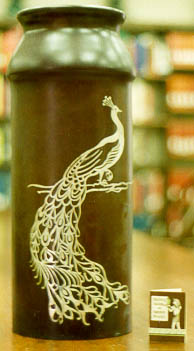
Pottery was an important part of the movement because it seemed to summarize all the basic ideals of Arts and Crafts-it was formed by hands shaping the products of nature into beautiful and practical items. Called art pottery, it was distinguished by the "soft transitions of color, the recognizable images from nature, and the Japanese approach to design." The Midwest was particularly rich in potteries, and Ohio could be considered the center of the art pottery movement in America. Indeed, America's first school of ceramics was founded at Ohio State University in 1894. Ohio was the home of the Rookwood Pottery in Cincinnati, and the Weller, Owens, Watt, Roseville, McCoy, Hull and Shawnee potteries near Zanesville.
Southeastern Ohio grew into a pottery center because of a ready supply of clay, coal, and transportation lines. The early farm potteries were known as "Bluebird" potteries because it was when the bluebirds returned from the South each year that the clay could be mined. At one time there were about 41 different potteries operating near Zanesville with names like Eal Run, Possum Hollow, Breadless, Poverty Hollow and Henpeck. Even though the movement ended around World War I, several Ohio art potteries continued production until much later, and some Zanesville potteries are still in production.
Weller and Roseville were commercial potteries in Zanesville that sought to make art pottery available at inexpensive prices for the mass market, a basic tenet of the Midwestern Arts and Crafts philosophy. Both of these potteries were influenced by innovation in pottery designs and glazes from Europe and the East Coast.
Located in Cincinnati, the Rookwood Pottery was the most important and influential of the Ohio art potteries. Like many such potteries, it was founded by a woman, Maria Longworth Nichols. Art pottery was a particular niche of women because many were involved in the genteel hobby of china painting, thought to be an appropriate outlet for women's artistic talents. Typical of these women, Nichols promoted her business as more interested in artistic expression than profit. In 1883, Laura Fry introduced the use of an atomizer for application of the decoration, and this technique became known as the "Rookwood Standard." It gave the pottery a subtle and delicate gradation in tones. Rookwood also experimented in underglaze decoration, and in 1889 Rookwood Pottery won a gold metal at the Paris World's Fair.
Mary Louise McLaughlin also played a major role in the Cincinnati art pottery movement. She discovered the process for "Cincinnati Limoges" or " Cincinnati faience," a process of underglaze decoration with colored slips. She founded the Cincinnati Women's Pottery Club, an outlet for young women interested in the "therapeutic" value of handcrafting items-one of the fundamental beliefs of the Arts and Crafts movement.
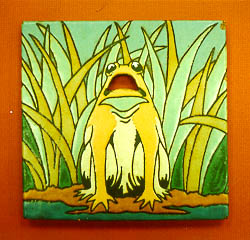
Both decorative and architectural tiles were a significant part of the Ohio and Midwestern pottery industry. The Pewabic Pottery in Detroit, the American Encaustic Tiling Co. and Mosaic Tiling Co. in Zanesville, and the Rookwood Pottery were particularly prominent in the production of tiles. Matte glazed plain or field tiles were particularly popular, but pictorial or figural tiles were also in demand. The latter were even sold individually as giftware.
About 1903, Mary Chase Perry founded the Pewabic Pottery in Detroit, Michigan. She also helped to found the Detroit Arts and Crafts Society. Perry began as a china painter and became more and more interested in glaze chemistry. The company specialized in unusual iridescent luster glazes, and Perry's pottery forms were kept simple to serve as a background for the glaze. Her matte glazes in brown, green, gold and red were a perfect complement to the Arts and Crafts furnishings of the day. She was friends with Charles Freer of Detroit, whose collection of oriental pottery is now at the Freer Gallery in Washington, D.C. The oriental influence is seen in her pottery design and glazes for tiles, architectural ornaments and vases. Pewabic Pottery architectural tiles can be found in St. Paul's Cathedral in Detroit and the National Shrine of the Immaculate Conception in Washington, D.C.
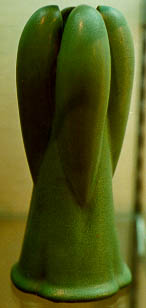
Teco Pottery in Terra Cotta, Illinois was another successful Midwestern pottery using matt-glazed ceramics. It was founded in 1886 by William D. Gates to produce architectural tiles as borders for walls and flooring, fireplace surrounds, and exterior trim. Gates had wide influence in the movement as president of the Chicago Arts and Crafts Society. Later, Teco produced vases in an uncluttered architectural style.
The art potteries in the Midwest were able to survive because they used industrial production techniques. With the collaboration of the artist/craftsman and commercial production, it was possible for the development of art pottery that met the philosophy of the Arts and Crafts movement of bringing objects of integrity and aesthetic beauty to a wide audience. That they succeeded is evident in the passion of collectors today to own this beautiful and functional pottery.
Other Decorative Arts
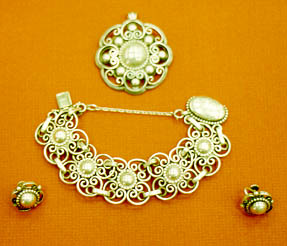
Metalwork produced as jewelry, furniture pulls, lamps, or containers was popular in the Arts and Crafts Movement. Silver and copper metalwork distinguished by the marks of the craftsman's hammer was typical. Copper was often used because of its low cost and pliability, and its dark patina harmonized with the fumed oak furniture of the period. The hammer marks, which would have been undesirable in pre-industrial America, took on important symbolism in the Arts and Crafts movement.
Robert Riddle Jarvie was a Chicago metalsmith who founded The Jarvie Shop. He became popular through advertisements in House Beautiful and the Craftsman, and was one of the most important metalsmiths of the American Arts and Crafts Movement. He first created his distinctive candlesticks out of copper, brass and bronze as a hobby, and later handcrafted simple yet lyrical bowls, bookends, trays and desk sets.
Clara Barck Welles of Park Ridge, Illinois began the Kalo Shop in 1900. The shop moved to the Chicago Fine Arts Building in 1918, joining many other craft shops there. Kalo metalwork was admired for its classic simplicity, quality of materials, and integrity of craftsmanship. The Kalo Shop was so successful that it remained in business until 1970.
Another woman important in Arts and Crafts metalwork was Frances M. Glessner. Born in Urbana, Ohio, she moved to Chicago where she became a social leader much involved in the Arts and Crafts movement. She studied metalworking under the master of metalwork at Hull House. Glessner was typical of other successful women craftsmen of the time. She had practical and savvy Midwestern roots, and she took full advantage of the opportunities offered by the Chicago Arts and Crafts Society at Hull House. Her interaction with the major figures of the movement allowed her, and other women like her, to achieve artistically and financially.
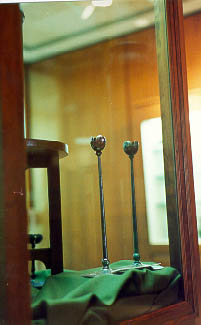
Karl Kipp was the head of the Roycroft metal shop. All Roycroft metal work was made and decorated individually by hand. Copper was the primary material, and the individual craftsmanship was evident in the slight variations of the same design. The production included early iron fireplace and garden implements, pentrays, ashtrays and letter openers. Dard Hunter's influence as a designer can be seen in the geometric clean lines of the metal work.
Also important to Arts and Crafts metal work was the Heintz Art Metal Shop in Buffalo, New York. In the early 1900s, the Heinz shop was using sterling silver without solder applied as ornamentation to bronze. The objects were distinguished by a variety of patinas and machine-shaped bases-very different from the hammered look of most Arts and Crafts metal works. Despite the death of its founder Otto Heinz in 1918 at the age of 41, the company continued until 1930, when it became a casualty of the Great Depression.
Leather work was another craft that grew in popularity during the Arts and Crafts Movement. Leather tooling began as an integral part of bookbinding, but the Roycroft Modeled Leather Department soon expanded into other gift items made of leather. The shop made boxes, purses, wallets, even wastebaskets. Leather craftsmanship became a major part of the production at Roycroft and leather products were sold as popular souvenirs.
Needlework of the movement is difficult to attribute. Textile and needlework societies were fashionable for women at the time, and embroidery, rug making and lace were all part of the work in textiles. Embroidery kits were advertised and popular for women to purchase and finish. Lace making in particular was important as it was usually done in the home by recent immigrants. Thus it met the Arts and Crafts ideal of philanthropic encouragement of artistic hand labor and the creation of beautiful and useful objects for the home.
Selected Item Descriptions
Rookwood Pottery, Cincinnati, Ohio.
A selection of Rookwood pottery showing the company's famous matte glaze. (On loan from the collection of Gordon and Lorie Wardlaw).
Bowl. S.A. Weller Pottery, Zanesville, Ohio
This piece is from the Sicardo Line, named for Jacques Sicard who developed the glazing technique that produced the lustrous iridescent metallic finish. Sicard worked for Weller from 1902-1907. (On loan from the collection of Franco Ruffini).
Vase. Roseville Pottery Co., Roseville and Zanesville, Ohio.
Typical of the Roseville pottery, this piece is finished in a matte green glaze and is embossed with a rectangle and strap patter mimicking hardware. (On loan from the collection of Peggy Zdila and Paul Kemner).
A Selection of Teco Pottery, Terra Cotta, Indiana.
While known for its architectural tiles, Teco also produced vases that echoed the architectural style. (On loan from the collection of Peggy Zdila and Paul Kemner).
"Little Bo Peep" Tile.
This tile might have been used as an architectural tile, or more probably was produced to hang on the wall in the way a piece of artwork might. The design is by noted illustrator Walter Crane, and the tile was probably produced by a Zanesville manufacturer. (On loan from the collection of Peggy Zdila and Paul Kemner).
Candlestick. Jarvie Shop, Chicago, Illinois.
One bronze and one copper candlestick typical of the Jarvie Shop. (On loan from the collection of Franco Ruffini).
Roycroft Tray. Shop of the Roycrofters, East Aurora, New York.
A copper tray hand-hammered in the metalwork shop at Roycroft, the tray is marked with the Roycroft cross and orb mark. (On loan from the collection of Gordon and Lorie Wardlaw).
A Selection of Heintz Metalwork, Heintz Art Metal Shop, Buffalo, New York.
Different from most Arts and Crafts metalwork, Heintz objects were machine-shaped rather than hand-hammered. (On loan from the collection of Janeann and James Hackley).
Kalo Sterling Silver Jewelry. The Kalo Shop, Chicago, Illinois.
Not all Arts and Crafts metalwork was produced for practical uses. Kalo jewelry was usually made of sterling silver, but showed a classic simplicity of design. (On loan from the collections of Rhoda Berkowitz and Janeann and James Hackley.)
Pillow Cover, Unattributed.
Embroidery kits were marketed to women as a way to express their craftsmanship, even though the designs were usually stamped on the cloth and left little room for creativity. This pillow cover was stitched with cotton embroidery floss on unbleached linen. (On loan from the collection of Peggy Zdila and Paul Kemner).
Back to Exterior  On to Demise and Rebirth
On to Demise and Rebirth
An Exhibit at the Ward M. Canaday Center for Special Collections, Carlson Library, The University of Toledo.
March 26th-June 30th, 1999.